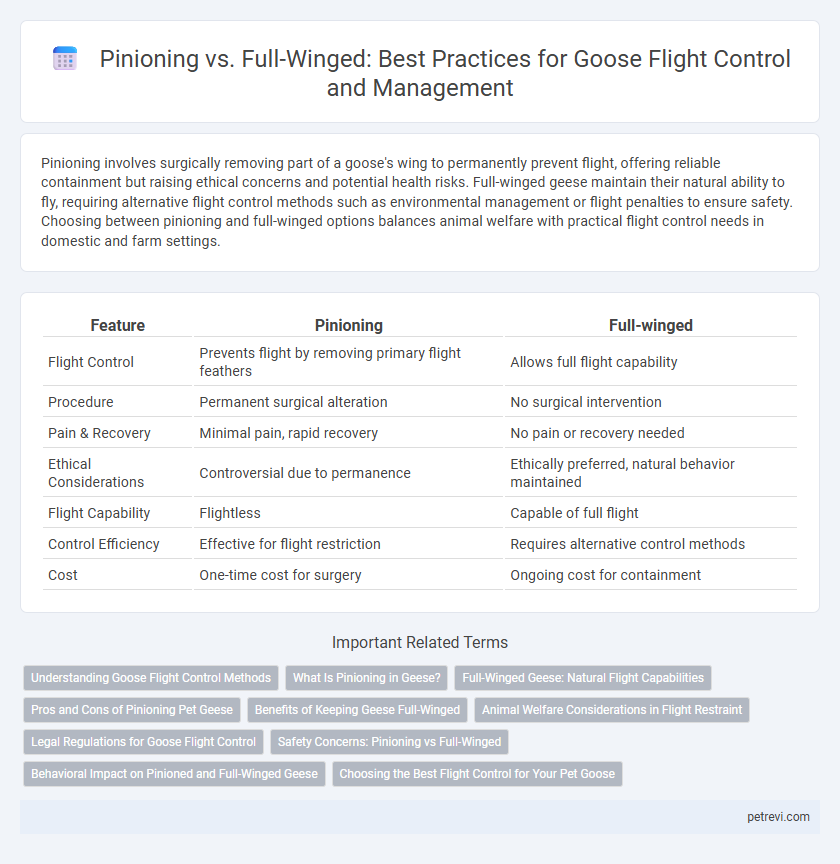Pinioning involves surgically removing part of a goose's wing to permanently prevent flight, offering reliable containment but raising ethical concerns and potential health risks. Full-winged geese maintain their natural ability to fly, requiring alternative flight control methods such as environmental management or flight penalties to ensure safety. Choosing between pinioning and full-winged options balances animal welfare with practical flight control needs in domestic and farm settings.
Table of Comparison
| Feature | Pinioning | Full-winged |
|---|---|---|
| Flight Control | Prevents flight by removing primary flight feathers | Allows full flight capability |
| Procedure | Permanent surgical alteration | No surgical intervention |
| Pain & Recovery | Minimal pain, rapid recovery | No pain or recovery needed |
| Ethical Considerations | Controversial due to permanence | Ethically preferred, natural behavior maintained |
| Flight Capability | Flightless | Capable of full flight |
| Control Efficiency | Effective for flight restriction | Requires alternative control methods |
| Cost | One-time cost for surgery | Ongoing cost for containment |
Understanding Goose Flight Control Methods
Pinioning involves surgically removing the pinion joint to prevent wing flight, effectively grounding the goose by disabling its ability to achieve lift-off. In comparison, full-winged geese retain natural flight capabilities, allowing controlled flight maneuvers essential for natural behaviors and migration patterns. Understanding these flight control methods aids in managing geese populations while balancing animal welfare and ecological impact.
What Is Pinioning in Geese?
Pinioning in geese is a surgical procedure that involves the removal or disabling of part of the wing joint to prevent flight, typically the pinion joint where the primary flight feathers attach. This method permanently restricts a goose's ability to fly, offering a way to control flight for domesticated or managed populations. Full-winged geese retain complete flight capability, requiring alternative flight management strategies such as habitat modification or netting.
Full-Winged Geese: Natural Flight Capabilities
Full-winged geese maintain complete flight capabilities due to intact wing structures that facilitate natural lift, thrust, and maneuverability, essential for migration and evasion from predators. Their unaltered flight muscles and feather arrangement allow precise control of wingbeat patterns, enabling efficient long-distance travel and agile in-air adjustments. Natural flight adaptations in full-winged geese enhance survival and reproductive success by supporting foraging, seasonal migration, and habitat exploration.
Pros and Cons of Pinioning Pet Geese
Pinioning pet geese involves surgically removing the pinion joint to prevent flight, effectively controlling their movement and reducing escape risks without requiring fences. This procedure limits natural behaviors, causing stress and potential long-term health issues, and is irreversible, raising ethical concerns. Full-winged geese retain full flight ability, allowing natural migration and exercise but require more secure enclosures and pose higher risks of escape and predation.
Benefits of Keeping Geese Full-Winged
Keeping geese full-winged preserves their natural ability to fly, which is essential for exercise, migration, and escaping predators. Full-winged geese maintain better balance and coordination, contributing to overall health and longevity. Flight capability also supports natural behaviors, reducing stress and promoting well-being in both wild and managed environments.
Animal Welfare Considerations in Flight Restraint
Pinioning involves surgically removing a portion of the wing's pinion joint to prevent flight, raising significant animal welfare concerns related to pain, long-term mobility, and stress. Full-winged geese retain natural flight ability, allowing for more natural behaviors, but require secure enclosures to prevent escape and predation risks. Ethical flight restraint prioritizes minimizing physical harm and promoting psychological well-being, making non-invasive methods preferable over surgical options like pinioning.
Legal Regulations for Goose Flight Control
Pinioning involves surgical removal of part of the wing to prevent flight, which is often regulated or restricted under animal welfare laws in many regions due to its irreversible nature. Full-winged geese retain their flight capability, requiring alternative flight control measures such as flight enclosures or tethering, complying with local wildlife and agricultural codes. Understanding jurisdiction-specific legislation is crucial for managing goose populations ethically and legally.
Safety Concerns: Pinioning vs Full-Winged
Pinioning geese involves surgically removing part of the wing to prevent flight, which raises significant ethical and safety concerns related to pain, infection risk, and long-term physical discomfort. Full-winged geese maintain natural flight ability, allowing for better escape from predators and improved overall health but require secure enclosures to prevent unintended flight. Balancing welfare and safety often guides decisions, with pinioning posing irreversible consequences compared to the more humane approach of managing full-winged geese through environmental controls.
Behavioral Impact on Pinioned and Full-Winged Geese
Pinioned geese exhibit limited flight ability, resulting in altered foraging patterns and increased reliance on ground-based behaviors compared to full-winged geese. Full-winged geese maintain natural migratory and escape responses, supporting stronger social interactions and territorial behaviors. Differences in flight capacity directly influence stress levels and overall well-being between pinioned and full-winged geese.
Choosing the Best Flight Control for Your Pet Goose
Pinioning permanently removes part of a goose's wing, effectively preventing flight but raising ethical and welfare concerns. Full-winged geese retain their natural flight abilities, allowing for better exercise and escape from predators, yet require secure outdoor areas to prevent unwanted flying. Selecting the best flight control method for your pet goose depends on balancing safety, freedom, and humane treatment, with many experts favoring full-winged care combined with secure fencing.
Pinioning vs Full-winged for Goose Flight Control Infographic

 petrevi.com
petrevi.com